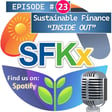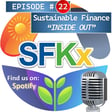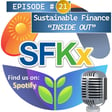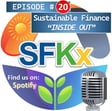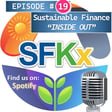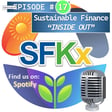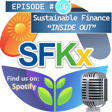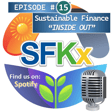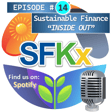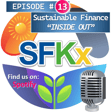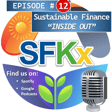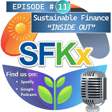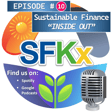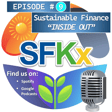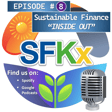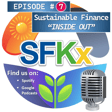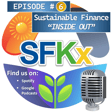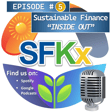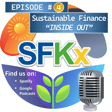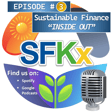Become a Creator today!Start creating today - Share your story with the world!
Start for free
00:00:00
00:00:01

SFKx Podcast Ep. 2 - Sustainable Finance "Inside Out"
Welcome back for a second edition of the best SF podcast going around.
You don't find this sort of golden content with a dash of humor anywhere else...so we've been told.
www.sustainablefinancekx.com
Transcript
Introduction and Role of SFKX
00:00:00
Speaker
Hello and welcome back. Some listeners will realize this is our second edition of SFKX Sustainable Finance, Inside Out podcast. We will look at things from all directions. Once again, you've got myself, SFKX DJ kicking us off. And very soon we're going to be joined by the main man, SFKX Guru to run through the latest happenings.
00:00:21
Speaker
So just briefly, once again, how we fit in the picture. Think of us as a curator of sorts, much like a museum or a gallery that curates paintings and sculptures, but instead we're bringing you the finest information about sustainable finance. Always find us online at sustainablefinancekx.com and from there you can find our Twitter and LinkedIn accounts as well.
Market Happenings and Bond Market Analysis
00:00:43
Speaker
Look, without further hesitation, let's bring in Mr. SF Guru. Mate, what's been going on in the market lately? Give us the lowdown please.
00:00:51
Speaker
Yeah, hi SFDJ. Good morning. Good afternoon. Good evening to our listeners, which will hopefully grow and blossom. Some of you will recognize at least my voice from a previous podcast.
00:01:02
Speaker
And we really hope and aim to bring a lot of the context of sustainable finance and most importantly, some transaction news. And hopefully our theme song and music comes through. It was cut off our first episode and actually reminds me there's a fair bit of bass going on there. We do have a blog and our website is your baseline bassless. And I guess our bass is a bit bassless at the moment because no one could hear it in our first episode.
00:01:31
Speaker
Look, as we always do in the podcast, we'll start with some market volumes and work through the news. Over the last, I guess, end of June, July period, the articles and the analysis comes out about the first half in terms of volume. We just want to start by taking a quick peek at those.
00:01:55
Speaker
And we've taken a lot of this research. There's some really good information from msci.com. Check that out. But where we've taken a lot of our research from is environmental finance. Do check that out. A lot of their stuff is subscription on a subscription basis, but you can always try the freebie for 30 days and check that out. But an excellent source of information. But look, Q2.
00:02:17
Speaker
if we if we look at that look no huge surprises and I'll explain this as a way that seems to be the stencil if you like it's a bit of an old word SF DJ the stencil of how to sort of trace around the main the main aspects of the market but look green bonds
00:02:35
Speaker
We're about 155 billion. It's about 60% of the labeled bond space. Again, we're not talking about SLLs. If we're talking about linked loans, you can say they're about the same size as green bonds. In some markets, higher. In some markets, lower. That loan market is always very difficult to get data, but let's just look at the labeled bond market. Green is the anchor. For this, about 60% of issuance, about 155 bill actually in Q.
00:03:05
Speaker
in Q1 and around that level, I believe, for Q2. If we look at, then, the Q2 continuing the shares, social bonds, 16%, a little bit down versus previous season. We've talked about that in our first podcast. The social bonds in isolation, if you like, a little bit down after the roaring period of COVID for social bonds,
00:03:33
Speaker
Sustainability bonds were around 17% of issuance. We'll talk percentage-wise, because I think that's more relevant than looking at exact numbers in terms of volume. So that was pretty static. Link bonds really climbing up a little bit. They sort of got hammered the back end of last year. And at least Q1, they sort of doubled
00:04:01
Speaker
versus what I think there were previous sort of quarters back end of last year. So coming back, but again, pretty patchy depending on what's happening in the market and transition bonds not too lively there with pretty minor issuance. If we have a look at the types of issuers, at least in Q2, if we just zoom into that,
00:04:24
Speaker
a little bit in terms of shares, we could say that agencies and MDBs about 15%, corporates about 30, FIs about 20, municipal's about 7, sovereigns about 14.
Geographic Activity and Market Dynamics
00:04:39
Speaker
So if you add up the sovereigns and
00:04:43
Speaker
you're talking about 20%, FIs 20%, corporates 30%. So what's that? 70% of the market is really in those sectors. And then you've got some agency and supernaturals around
00:04:55
Speaker
around that from a geographic point of view. I mean, we're based or heavily sort of influenced by Asia because we both sit in this region. But if you look at at least having a quick sneak peek at back jumping to Q1. So I know I'm jumping between Q1 numbers and a little bit on Q2. Not all the numbers are available for Q2. But let's just have a look for that first half. Europe about
00:05:25
Speaker
about 50 percent, Asia about 15 percent. So that's come off from the traditional about 20 percent. So a little bit more pressure on the Asian numbers. Supernaturals, pretty steady. America's, believe it or not, even with that weaponization going on on ESG, stable at around 10, probably underweight for the biggest capital market in the world. And again, this is just on bonds. Middle East, pretty small, about 4 percent. Central America, one. Oceana, about two. So
00:05:55
Speaker
Yeah, that's sort of the spread. And look, there's ongoing issues, as we know, that are written up, connected to the first half in terms of impact reporting, how good that is, how good it isn't, what are the flows into funds that specialize in this? Do funds need to label themselves a different way to meet certain greenwashing or other requirements, the greenwashing concerns on the link? So it's sort of a real melting pot still.
00:06:25
Speaker
And then, as we always know, the action in sustainable finance is not devoid of what we're seeing in the rest of the broader market, so high yields being under more pressure, which means investment grade, which means maybe a little bit less diversification, social under a bit more pressure, linked a bit patchy, and then loans we don't have extensive data for.
00:06:46
Speaker
Yeah, in a bit of a rather large nutshell there, that's sort of some of the trends and volumes in action. Broadly speaking, again, we're not trying to give people exact pinpoint number by number, but just try and paint a broad brush, if you like, across the market. A few other things to sort of highlight, SFGJ, and for our listeners, there's been a lot of articles about the heat wave. So if people don't think climate
00:07:15
Speaker
and climate change is impacting us now, I'd suggest you go to Greece or somewhere like that, that's really copped a lot of the brunt of some of these heatwaves. We know there's El Nino and other things complicating that further, but I think it just shows that, you know, this is, it's game on now. What else are we seeing? A lot of articles about the insurance sector. Unfortunately, the Netzera Alliance of Assurance has sort of disintegrated, but the heat's coming, pardon the pun,
00:07:45
Speaker
on insurance sector in terms of what they're doing to align to net zero, solvency plans, transition plans. And that's good. I think regulators wanting to see transition plans as well as, well, what's your solvency ratios like as well. And that links into the FSB Financial Stability Board. I think that's in the UK. Someone might pick me up on that.
00:08:07
Speaker
exactly where that institution is. But the ongoing need request for further examination and presentation of transition plans is really coming out on lots of different angles. And I think that'll just be in the briefcase, so to speak, of what corporates need to have to show investors or show for stakeholders is financial CSG ratings and transition plan is just so crucial.
Sustainable Finance Innovations and Challenges
00:08:35
Speaker
you've got to be on top of that. So that's really good too.
00:08:39
Speaker
Really good to see. One of the references we really like here at SFKX is the TPI or the Transition Pathway Initiative. I think we also mentioned this in our first episode. There was an excellent publication on aluminium, again, hard to abate sector, a lot of renewable, sorry, a lot of the energy powering aluminium, not on the greener side, hence the variation in terms of carbon intensity for aluminium production is very, very varied.
00:09:08
Speaker
And we need aluminium or we're not going to get to net zeros because most turbines and wind farms and all that sort of equipment, aluminium is pretty much irreplaceable. So do check that out. What else have we seen? A little bit of sort of, wouldn't say controversy, but that ongoing rolling mall, if we use a rugby term from a responsible investor talking about, I love this heading, a sledgehammer to crack a nut. Shouldn't say.
00:09:37
Speaker
much about nuts, but anyway, cracking a nut. The EU conflict of interest rules for ESG ratings. Look, I think that's just ongoing, like what we said in previous podcasts, too, and people will hear me who know us, ESG data, ESG rating, second-party opinions. It's just this ongoing way. Again, is there a way to overcook the regulations for ESG ratings? Look, at the end of the day, they're crucial to attracting capital. They're more important.
00:10:04
Speaker
So discipline around those and having all the good things we need, I don't think we can overdo that yet.
00:10:13
Speaker
Anyway, we'll see how that goes. Articles about the agri sector, articles about taxonomies and common ground taxonomies with what's happening there with the PBOC and the EU in China. I love this article about environmental finance. Again, check that out. Biodiversity credits, next logical step for positive impact. Got to take a breath there. I think that's just a logical step. Carbon credits.
00:10:40
Speaker
And we know they're going to be sort of disaggregated into their social elements of those as co-benefits. And one of the co-benefits for those is biodiversity.
00:10:51
Speaker
But seeing that whole biodiversity market change and grow, and I don't think there'll be an offset market for biodiversity. It'll be because I don't think anyone's going to set out to destroy a certain amount of biodiversity and then buy some recompense for that. So let's see how that goes. Don't know a whole lot about it, but I know it's coming. When those things come, they will get integrated and sucked into sustainable finance, which is good. The more instruments, the more ways of monetizing different projects to get money where it's needed. I think that is
00:11:21
Speaker
I think that is great. Like what we said before in the market summary roundup, the real impact or the impact of sustainable bonds must evolve from signaling to real world impact. And that's one thing for those who know me as well, or us at SFKX that we've talked about for some time, labeling is great, but it's really step one.
00:11:41
Speaker
If we label something and it doesn't have any impact, it's nice, yeah, great, excellent, like a cool dance move, looks good, but what does it actually impact? And I think that's a good thing. And I hope that that magnification or that magnifying glass, if you like, from investor stakeholders on the market continues because that's what's needed to keep pushing these products from labeling to impact, have both for sure.
00:12:07
Speaker
Some securitization articles, that coming back, aquaculture, like what we said before, related to Agri. Social taxonomy, a little bit of talk from Responsible Investor. We'll see how that goes. We know that SFDR and regulations for fund managers in Europe have kicked off recently.
00:12:27
Speaker
and what primary adverse indicators you're measuring on companies, what should be environmental, what should be social, whether the EU reverts back and starts to think about their social taxonomy, which had been mothballed for a while. Let's see, articles about blended finance, which is great. Greenwashing we mentioned before. A little bit of talk about whether your IMO in terms of hard to abate sectors, we'd like to talk about them because they're interesting and challenging and sustainable finance needs to get money to those sectors because they're pretty polluted that we need them.
00:12:57
Speaker
As far as I know, shipping is still gonna be needed. And the IMO may be shifting if they haven't already to 100% reduction target by 2050 rather than 50%. And that will change, I guess, the curves and level of ambition for a lot of linked instruments that are pumping into shipping. Let's have a look. Look, I really think they're the main issues that we've seen over the month. Ongoing talk about whether scope three should or must be included in
00:13:25
Speaker
in SLBs, things like that, ISSB and harmonization we talked about last time, sovereign bonds in terms of the pricing of those and really starting to get impacted in a much more tangible way by assessments around transition and those sorts of things, biodiversity, adaptation, finance, transition plans, greenium still being debatable.
00:13:50
Speaker
similar issues we've talked about, or we'll be talking about going forward on the podcast, so we won't talk.
00:13:57
Speaker
I'm too much about those, but just a quick shout out to, for those interested in what I was talking about before, that aluminium side or the need for some of these sectors or the products coming out of these hard to abate sectors like steel, like aluminium, there was an excellent, excellent resource by the Energy Transition Commission. And I'd highly recommend that for any of our listeners to check that out. Excellent, excellent pieces and detailed infographics about lots of different sectors.
00:14:25
Speaker
and a really good piece on material and resource requirements. There was also an IRENA, which I can't remember what that stands for. I think International Renewable Energy Agency and other UN agency do check those out because this whole critical mineral issue I think is really going to be a fascinating topic. And as we know,
00:14:48
Speaker
mostly in taxonomies, the act of mining some of these commodities is not really seen as green yet. Maybe it will be in the future. It's the activities around that that are making that greener or more sustainable. But do check those out, because obviously, we're going to need to increase the supply. Resources are around, but we need to increase the supply.
Sector-Specific Insights and Activities
00:15:11
Speaker
So time for me to take a breath. And
00:15:13
Speaker
Back to USF DJ, what's next on our list?
00:15:19
Speaker
Well, that was certainly a full card of the market, rapid news and events. You certainly across that we've had, we had insurance, aluminium, we've had nuts. We talked about greenwashing, some weaponry, obviously shipping. And it's funny you talked about shipping too. It's a nice tangent. So SFG or SF Guru, if I can use your full name, let's just change a tax slightly, slightly like a good sailor might do, I guess. And tell us about the happenings around sustainable finance linked instruments, always an exciting part of the market or part of the sector, please.
00:15:48
Speaker
Please, let's move on to that next, can we? Absolutely. So, as we all know, or hopefully the folks listening in have sort of, you know, tacked onto this if we like, that, you know, the use of proceeds is a traditional part of the market. Linked, newer part of the market, more opaque if it's loans, more transparent if it's bonds. And it's easier to throw shade at the linked bond market or linked loans because ambition is a bit more judgment-based than a bit more black and white.
00:16:17
Speaker
black and white base. So definitely the more dynamic part of the market and we can all have our different views about how ambitious something was or isn't but we just like to talk about transactions that have happened and what sort of sectors and really we'd love our podcast to spark some ideas for that's interesting a data center a property a municipal doing different things if that sparks some ideas to
00:16:43
Speaker
grow the market and get some money to where it's needed, that's great. And we can all debate the level of ambition on these things. And debate on a nuanced way is good. Debate that's very high level is often meaningless in these more sophisticated markets as we go forward. So look, real estate continued to be one of the mainstays, as it is on the use of proceeds, part of the fence. So we saw Net's REIT in the US do a link
00:17:10
Speaker
a LinkedIn instrument, GHG focus according to SBTI or a science-based target initiative approach there. We saw some data centers, SunVision, getting a link loan in Honky, $3 billion there, presumably in Hong Kong. What else we got here? Another property for our FIBRA, Dan Hoss.
00:17:32
Speaker
slightly odd name, but hopefully I said that sounds like a German movie star, like a Hasselhoff. But anyway, a fibra Dan Hoss, maybe he's a friend of Hasselhoff. What else we got here? Cybus did something as well. Merrill in terms of something in Iceland, Blassen,
00:17:56
Speaker
I think that's over in India side, some chemicals, Ambia over in Sweden. Again, the KPI is on that one, GHG is still anchoring most deals. GHG is a very metric based employee engagement tool as well. And probably an aspect of that is just a tip when you're looking at transactions, I'd say employee
00:18:23
Speaker
you know, net engagement scores, that sort of thing. Interesting how that can be used, and it can, but always better if there's a really robust approach to that, and ideally a third party rather than a customer's.
00:18:34
Speaker
or an issuer borrower doing that by themselves. Anyway, going off on a tangent there, an improved care receiver or customer care received. So again, some of those things a little bit harder to measure, but if there's a robust, I should say, methodology there, that's a good way to do it there. So yeah, that was a little bit on the property side.
00:19:01
Speaker
and not the property side, the link side, I should say, I'm tangling my, tangling myself. But what about, back to USF DJ, I think for use of proceeds, we'll sort of cut over back to that direction. Yeah, exactly, Mr. Guru. We saw this during this part of the podcast, we normally flip over and talk about some highlights, recent highlights around the use of proceeds. Now that we've covered off the link part, let's move on to the use of proceeds and not delay any further.
00:19:30
Speaker
Cool. What we normally do in the podcast, we break this up into municipal sovereigns, banks, and then corporates in the different sectors. We find that that's a good way to present because
00:19:43
Speaker
People would have heard me say this before, sovereigns catalyse the market. Often banks are crucial players because the size of their books and how many different types of borrowers they have. And then obviously that corporate piece calling out specific sectors is really important as well. So let's have a look, a little bit of action in Latin America. Brazil hiring banks to prep and ESD to do, I think a little bit of talk about linked instruments there.
00:20:14
Speaker
Australia or Aussie land, which is close to our hearts, a little bit more action on those on the sovereign there. So let's see when that can happen. Back over to India, a little bit more talk of doing another series of grain after some pretty successful issuance last year. Zagreb, I'm going to say Croatia for that one, but I actually don't know specifically. No, no, that's correct.
00:20:37
Speaker
Excellent. My geography hasn't left me. Thank you. From a municipal perspective, good to see, again, sovereigns, but municipals are very important, too, and there's different funding methods for councils, municipals, you know, globally. If we cut over to banks, again, EU, pretty active council of European Development Bank, doing a bit of social bond there. We also saw some action in
00:21:05
Speaker
in Abu Dhabi, Abu Dhabi Islamic Bank on the side. And again, we won't go through all the different things that banks fund under that, but generally it comprises of properties, renewables, water, infrastructure,
00:21:20
Speaker
waste management and all those common sort of things. And then often SME style lending, microfinance style lending. So they're really good places. If anyone's listening going, I wonder what are the different types of things that you could broadly fund in these markets. The banks have the broadest frameworks. And what that means is the opinions connected to those from a number of different external providers are really, really useful because there's so many different things covered.
00:21:45
Speaker
Anyway, off in Tangentland again, back to it. Leverage Buyout was done by Sinven, a consortium of UK Private Equity. I think it was Energy Transition Product Distributor. I may have messed that up a little bit, but it's interesting that where these instruments are being used as well,
00:22:09
Speaker
So leverage buyouts acquisition, no issues in that acquisition sometimes. Someone used to process point of view can be a little bit deviable on goodwill treatment and those sorts of things. But again, if the buyouts on the table and there's assets involved, why not? If we jump over to insurance, there was Zurich up's minimum deal for a green bond IFC active again. Banko to Credito in Peru.
00:22:38
Speaker
What else have we got? KFW, again, active in the market, Tatra Bank, Mizzoujo, those sort of players. If we then look at another mainstay of the market, utilities, renewables, BIDCO, green BIDCO, that might be a bit of a typo. There sounds pretty generic. Over in Spain, Genia, over in, where was that one? In LATAM, PV Tech, all these renewables, Turner,
00:23:08
Speaker
Abu Dhabi's Mazda active there. So pretty broad geographic. So what we like to see at SFKX is geographic diversification, product diversification, sector diversification, and sometimes you'll see that all in one sort of flurry of activity in the market. South Africa was active with
00:23:29
Speaker
1.5 billion water fund, I'm doing something there, housing, property, soba, Realty, Cromwell in Australia, Ivanhoe, Cambridge, I think over in the UK. And then on a little bit of a different tact again, some of the hard to abate sectors. And again, some countries, some jurisdictions will prefer to label this like Japan is more of a
00:23:52
Speaker
transition type label, not as firmly developed as green, so to speak. But we saw a little bit of activity in China, Steel Mills. We saw some action in LNG. And again, some of those things are a bit debatable. We can talk about some of the aspects of that going forward. Speaking of transition and green,
00:24:20
Speaker
NY or Nippon Usen is a Japanese company in transition label instrument. Again, you could call that green maybe. Transition's a good label on a user proceeds basis as well, but the market will continue to grow on that. And then just to finish off a
00:24:41
Speaker
a couple more. Healthcare provider Activus did a social bond on the healthcare sector. Again, that's good, whether that's for property, whether it's for services, air liquid, looking at some low carbon hydrogen production there, and then to finish it off machinery and engineering. And as we know, construction can be a little bit tricky. Generally in the use of proceeds market, it's often
00:25:05
Speaker
the purchaser of what's being constructed, that the asset will sit on their balance sheet longer term is who you would label rather than the construction company. But sometimes construction companies have, you know, special equipment. And as the market sort of moves to more acceptance of short-term facilities, maybe that's more of a revolving fund because we know that a lot of property is on a cost-to-complete basis. Fund in the short-term, label that, and then it goes more up and down.
00:25:33
Speaker
Let's see how that goes because I think obviously construction companies are needed, not just more of the asset owners and sponsors who own this stuff going forward.
Emerging Trends and Transition Plans
00:25:43
Speaker
So, are we nearly up to FAQs? Did I skip that?
00:25:52
Speaker
No, no, we're right on the money. So nice cover off on the use of proceeds, especially on that little bit of technical information on construction and how it works in that sector. Really, really nice piece of explanation there, Mr. Guru. Now you're right. We are on to the FAQ. So this is where we have
00:26:08
Speaker
We basically come across questions that have come across our bow from various parties. We've got, I think, three today. I'll go with the first one. Someone's asked a nice one. What are the elements? What are the emerging elements in a good transition plan? Can you please explain? Yeah, I'll give a relatively short answer for this, because I think hopefully our listeners have got some idea about governance, short-term, medium-term, long-term targets, and those kind of fundamental aspects of a transition plan. But there's a lot of
00:26:38
Speaker
market, say noise in a positive sense. So there's a transition task force set up or transition plan task force set up in the UK. I'm going to say TPT. I actually can't remember their acronym, but if you look up transition task force, check out what they're producing. Some really good stuff because as I said before, that suitcase for corporate banks, FIs, you got to have a good transition plan. If you don't, you're going to be suboptimal when you raise capital and other things in our view.
00:27:09
Speaker
But I think the newer emerging elements that will probably start to get talked about more is a couple of things. So the social dimension in terms of just transition and the people side of decarbonisation, often transition plants still focusing a lot on that carbon reduction, which is good, but the on-flow of that to communities and people and other things. The other one is nature and biodiversity too. So we know that
00:27:32
Speaker
Essentially, the economy is a subsidiary of nature, if you like. I've read a little while ago, I love that sort of saying, but nature, biodiversity and those dependencies and risks being covered off, I think are really crucial things. And then probably not a new one, but a little bit new. The use or extent of the use of carbon credits is still
00:27:55
Speaker
You know, debatable, and we wouldn't like to see plans dominated by that. Aspects of plans, looking at that in an interim period before something else is done. And really, that's a sort of a last resort.
AI's Role and Global Developments in Sustainable Finance
00:28:09
Speaker
So hopefully I did that some justice. Pepper me some more, SF DJ. And I think these are from Murray, aren't they, our friend Murray?
00:28:19
Speaker
A good point, yes, from Murray, our AI bot. Funny enough talking about AI, for example. Interesting question that came across from Murray. What role does AI play and how is this connected to sustainable finance at the moment, in your opinion, Mr. Guru? Yeah. Great question. It's a bit ironic, isn't it? Our AI bot, Murray, is asking us a question about AI.
00:28:44
Speaker
but look, I'll hopefully try and do that some justice. So look, I think AI, let's sort of zone, not zone out, I'll try not to zone out, zoom out, zoom out is the right word. So if we zoom out a little bit, you know, digitization, optimization in terms of things in hard to abate sectors and overall decarbonization are really important.
00:29:11
Speaker
So a more efficient manufacturing process, a more pinpoint agricultural process, you know, all of those things that use technology and digitization.
00:29:23
Speaker
and then more and more now AI has a real role to play in decarbonisation. The first time I heard that, I'm like, what the heck does that have to do with decarbonisation? But it's all about efficiency. If you can do more with less, generally that should mean lower emissions. I know we're still looking in a narrow focus for decarbonisation. So I think there's the AI connected to things like IoT, machine learning,
00:29:52
Speaker
you know, recognition of certain patterns and the extent to that driving efficiency
00:30:03
Speaker
efficiency using something being more productive, higher yields is good because you're doing more with less. Essentially, that's what I see. And just to remind me SFDJ, there's a blog coming out on our website, I think to do with this exact topic. It's either on there or we'll be on there. And I always forget what we have on our website. You're always jumping ahead of the gun. We'll be on there very soon. Probably the next one. If you think looking at our list of articles, the next one coming up will be about AI.
00:30:32
Speaker
No, that's great. And I think in that article, we also talk about, you know, Johnson Controls even called out, you know, funding AI initiatives and Johnson Controls are about sensors and about Internet of Things. All of these type of things which drive efficiency and drive more pinpoint and drive higher yields is all good, is all good stuff there.
00:30:52
Speaker
So as we round the corner to the home stretch, we've got one little section to go. This is around the products and programs that integrate sustainability. Also, regulations that have shown some major developments of recent. Can you just maybe close off that last part, SF Guru? Yeah, so when we look at a couple of these areas, again, we'll try not to go too reg, heavy and more focused on the key highlights a little bit earlier in the podcast. But let's look at the products and programs
00:31:22
Speaker
Green savings accounts were talked about deposits previously, FX derivatives, that sort of thing. Haven't really taken on. Lloyd's Bank was coming out with sustainable FX agreements. I guess that's either connected to sustainable companies or a linked element on those. Normally not used to proceeds connected to reduce more sort of linked structures. Excuse me. Speaking of linked structures, linked deposits.
00:31:49
Speaker
Um, again, you haven't seen as many, um, as many of those, but BMO launched, um, an innovative approach to that. Do check that out. Some programs for SMEs. And I really think we're going to see, and I think even on our first episode of our podcast, we talked about, we talked about SMEs, um, and the lending connected to, um, the lending connected to those. And I think that's really gonna get a boom because, you know,
00:32:17
Speaker
Sustainability is not an elitist topic. It has to go out and be embedded across all parts and supply chains many, many times as flows through from SMEs to bigger companies. Sustainable trade finance, we'll talk about in future podcasts. Again, programs coming out or being talked about for those.
00:32:36
Speaker
And then CBUS managed to fund some food growers on environmental finance. You can check that out. So agri-style programs. So again, what we're seeing from banks is integrating sustainability, generally linked aspects in products, and then some particular funds or some particular banks doing more thematic work around agri, around EVs as we go there.
00:33:02
Speaker
Couple of things on regs. EU is just an ongoing mall that we talked about before. There's nothing really incredibly else to say about that apart from SFDR, CFRD. I don't know if I've got CFRD the right way around. Basically, lots of ongoing regulations in any EU land, which will force more companies to have to report on sustainability, which is a good thing. Teething problems, of course, but a good thing overall. And then SEBI.
00:33:30
Speaker
The regulator in India has really launched a number of different consultations and rules and regs about different aspects of green deposits, some ESG ratings, and the regulatory regime there. And that's an interesting aspect. Japan's been pretty progressive. India's been pretty progressive.
00:33:52
Speaker
do check those out. So I'm going to take a few more breaths and hand back to you SF DJ to take us to the finish line for episode number two. And we really hope that our content is coming to you thick and fast. We'll keep pumping up the episodes and that's sparking some good ideas and thoughts and adding some lively aspects and really trying to connect what's going on in the broader markets and splash a few transactions in there and talk about how this all connects together. So
00:34:45
Speaker
Yeah, over to you SF DJ to get us to the finish line.
